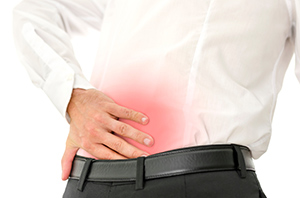Lower Back Pain Treatment
Dehydrated Discs in Lower Back

Low back pain is a common complaint in the middle ages and lumbar degenerative disc disease is a common cause of low back ache.
With the normal aging process or with repetitive trauma the discs in your lumbar spine become dehydrated and develop fissures and may be prone to herniation or rupture. There are now a range of treatment options available which can improve the quality of life.
Diagnosing Causes of Lower Back Pain
Physical exam may show generalized limitation of motion of the lumbar spine particularly in forward flexion. Reflexes and motor strength in the lower extremities is usually normal. The degenerated discs may lose height and this may be visible on plain X-rays. There may also sometimes be instability and "slippage” of the spine also called spondylolisthesis or a backward slippage called retrolisthesis.
The dehydrated discs may be diagnosed on MRI where they show darker signal intensity than the well hydrated normal discs which are normally bright on certain image sequences. This can sometimes be an asymptomatic finding in a lot of individuals. In cases of doubt a lumbar discogram may be helpful in determining which "dark” discs are "pain generators” and which are just an incidental finding on MRI.
After this information is obtained it can be determined which lumbar degenerated discs, if any, need to be treated as a cause of the low back pain. A thorough workup should include the elimination of other causes of lower back pain such as sacroiliac syndrome or sacroilitis or facet pain syndrome or lumbar facet joint arthritis. This can be done by careful physical exam and by doing diagnostic and therapeutic injections o these areas.
Lower Back Pain Treatments and Pain Relief
Once it has been determined that one or more discs are the actual cause of the low back or leg pain, there are now a range of treatment options available.
Traditioanl Treatment with Lumbar Spine Fusion
The traditional treatment for back pain has for a long time been lumbar spine fusion. Lumbar spine fusion can now be achieved in many ways, from the front of the spine only (anterior fusion), from the back of the spine only (posterior fusion), or from both the front and the back (360 degree fusion).
There are now also options of fusing certain levels from the side and the lowest disc level from below. The recovery time for lumbar fusion surgery for lumbar degenerative disc disease can be more prolonged than other modern options as actual healing of the fusion must take place which may take months. There are now substances known as BMP’s (bone morphogenic proteins) available which have been shown to enhance fusion rates and even accelerate the time to fusion.
Despite the advances in lumbar spine fusion technology there are other motion sparing options which may be more preferable than spine fusion.
Disc Replacement
The degenerated disc segment may be replaced (disc replacement or spinal arthroplasty). There are now two disc replacement devices that are FDA approved, the Charite disc (DePuy Spine) for one level lumbar degenerative disc disease or the Prodisc (Synthes Spine) for one or two level lumbar degenerative disc disease.
Charite Disc
The Charite disc is a non constrained design which has two porous coated metal endplates and an unconstrained polyethylene core. This mimics the natural motion of the lumbar disc segment. The Charite design features six teeth in each metal endplate to help anchor it to the vertebral body endplate as a press-fit design. This design has been extensively tested in Europe and the USA and has been shown to be equivalent to lumbar fusion in USA FDA studies.
Prodisc
The Prodisc spinal arthroplasty implant features a metal keel in the midline in each endplate and a semi-constrained polyethylene core that locks to the lower metal endplate. This implant may be used in the USA for up to two levels and also mimics the natural motion of the lumbar disc segment.
Spine Stabilization Devices
Dynesys Stabilization System
There are also dynamic stabilization options such as the Dynesys System (Zimmer Spine) device. The Dynesys is a construct that uses titanium pedicle screws linked by a polyethylene cord with polyurethane spacer tubing in between the screws. This stabilizes the spine yet allows motion thereby avoiding one of the sequelae of lumbar fusion known as adjacent segment disease.
Scient'X Semi-Rigid Pedicle Screw Systems
Another dynamic spine stabilization system is the Scient'X rod system which has a flexible joint between one of the pedicle screw segments. This is a good option where fusion may be desired at one or more levels but the level above or below the fusion needs to be stabilized to prevent any gross motion such as translation yet allow some motion in flexion and extension in a more normal plane of motion.
Schedule Your Consultation Today!
Whether your eventual treatment option is non-operative, lumbar spine fusion, disc replacement or disc arthroplasty or some form of dynamic stabilization, your spine surgeon can help you decide on the best option based on your current symptoms, lifestyle goals and expectations in an individualized way.
The evaluation and treatment for low back pain has come a long way and with advanced imaging it is now possible with more certainty than in the past to narrow down and find the likely cause of your "back ache." With the range of options available you may well have the option of reducing or eliminating your bad back.
To schedule a consultation with Texas top spine specialist, please call (210) 265-1116 or contact us online today.


